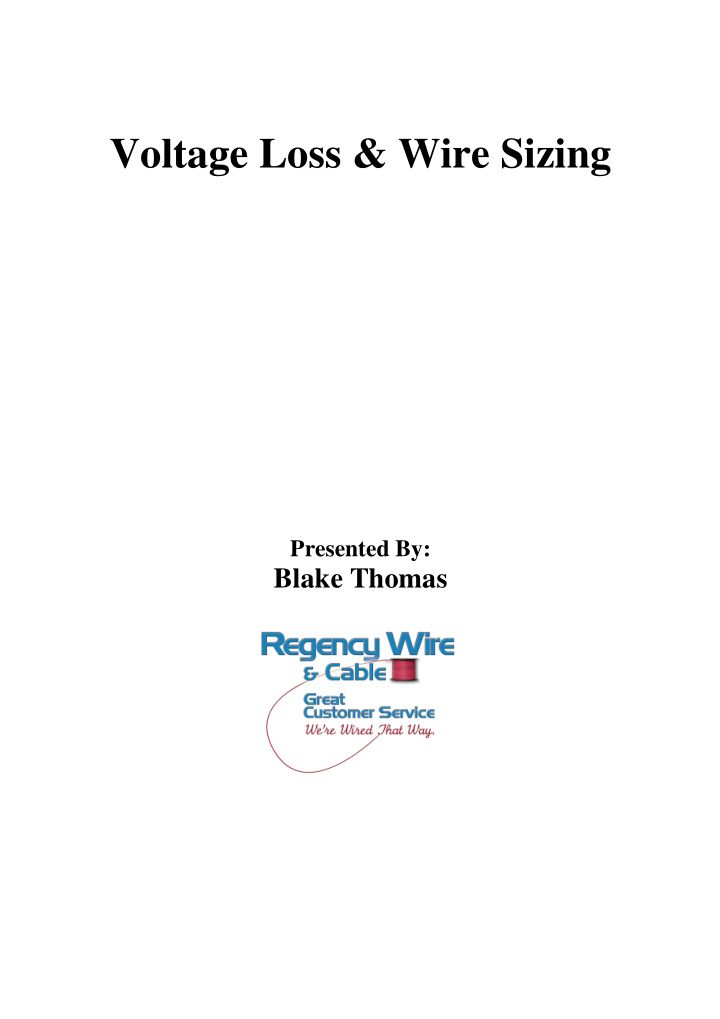



Voltage Loss & Wire Sizing Presented By: Blake Thomas
What is voltage loss? Current is the movement of electricity through a conductor but voltage is the force that moves the current through a conductor. Voltage is to electricity what pressure is to water. Pressure moves water down a pipe. Voltage moves current through a wire. We experience pressure loss in piping called “friction loss”. • Smaller pipe and/or longer distance = more friction = pressure loss. We experience voltage loss in electrical wire. • Smaller diameter wire and/or longer distance = more resistance = voltage drop. Why do we need to size wire? 1. Because of voltage loss we must size electrical wire to accommodate optimum performance of the solenoids in the control valve. • Wire that is sized too small will cause excessive wear and tear on components. *Just because the solenoid works does not mean the wire is sized appropriately. • Wire that is sized too small will, in a worst case scenario; prevent a component from functioning at all. 2. Wire that is sized too large is a waste of money. What do we need to know to size wire? The easiest and best way to size wire is to follow the component manufacturer’s recommendations. This is found on spec sheets and product catalogs provided by the manufacturer. The manufacturer has insight into the construction and optimum performance of a component that a wire manufacturer cannot know. In the absence of a manufacturer’s recommendation we can calculate our wire size if we know four readily available variables. 1. R = The resistance of certain gauges of wire. This information is easily obtainable from a wire resistance chart. 2. AVL = The acceptable voltage loss. The industry standard for voltage loss from controller to valve is 4 volts. 3. L = Length of the wire run.
4. I = Inrush current (expressed in amps) of the solenoid being powered. This information is supplied by the valve manufacturer. I know the distance from my controller to valve. How do I figure out what wire size I need? We can choose a wire gauge from a resistance chart if we know what resistance our wire run will tolerate and stay within our acceptable voltage loss. The formula: xAVL 500 = R LxI It’s simply a matter of filling in the blanks with the information we know. AVL = 4 L = 1000’ (hypothetical) I = .3 amps The formula: x 500 4 2000 = = = R 6 . 66 x 1000 . 3 300 We now know that, based on our calculations, our 1000’ run of electrical wire will render a 4 volt loss when using a solenoid amp draw of .3 amps when wired with a copper wire gauge that has less than 6.66 ohms resistance. 18 awg = 6.51 ohms per/mft
I’m using an 18 awg multi-conductor wire for an irrigation project. How far from the controller can I set a valve? Again, we can apply the variables we know to find the one we don’t. Since we now know our resistance but not our length we can exchange the variables in the equation. The formula: xAVL 500 = L RxI Again, we fill in the blanks with the variables we know. AVL = 4 R = 6.51 (18 awg) I = .3 amps The formula: x 500 4 2000 = = = L 1024 x 6 . 51 . 3 1 . 953 We now know that, based on our calculations, our 18 awg copper wire will render no more than a 4 volt loss when used with a solenoid drawing .3 amps if we run it 1024 feet.
Let’s Review • Voltage is the force used to move electric current through a conductor. • Voltage loss is a result of resistance incurred from either distance or diminished wire diameter. • Wire should be sized appropriately to ensure optimum performance of wired components without “over building” and wasting money. • Just because a component will run does not necessarily mean the wire is sized appropriately . • Incorrect wire sizing will result in unnecessary wear and tear on wired components. • We need only know three of four variables to correctly size wire. 1. R = Resistance (from a wire resistance chart) 2. AVL = Acceptable voltage loss 3. L = Length of the wire run 4. I = In-rush current expressed in amps of component to be wired • The same formula can be algebraically altered to find either the wire size needed or the length a specific wire gauge can run. xAVL xAVL 500 500 = R = L LxI & RxI
Recommend
More recommend